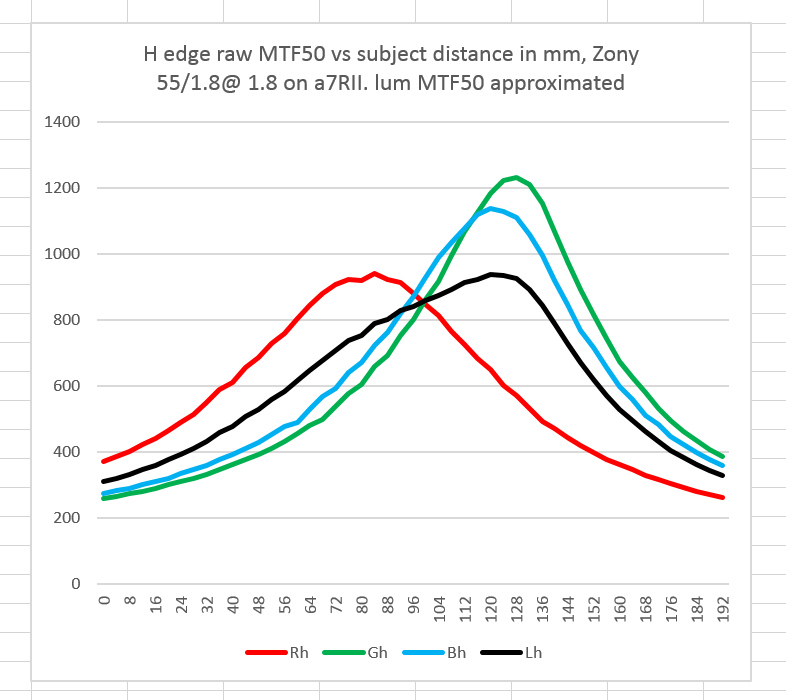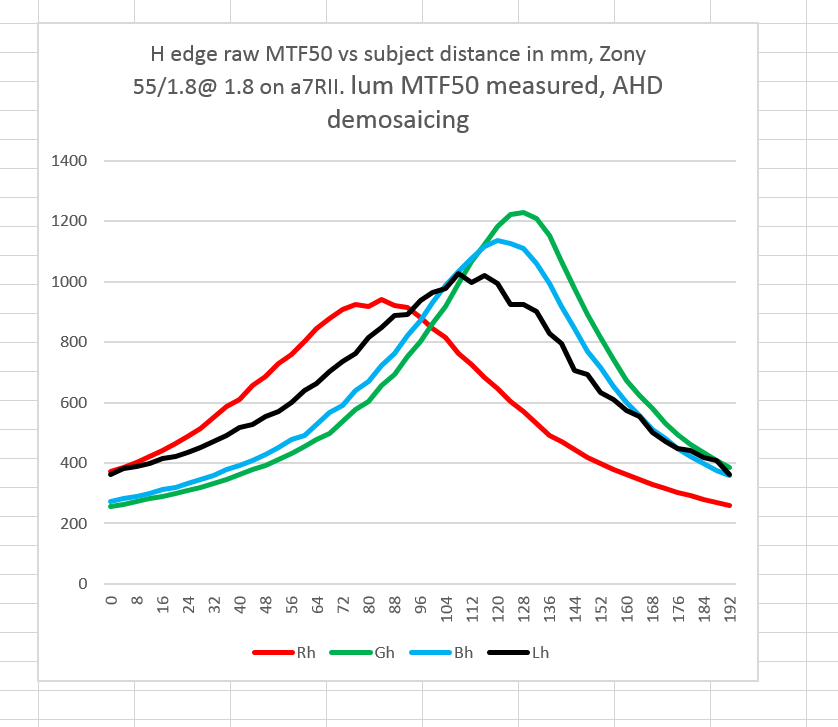When you focus using the LCD screen or an attached monitor, with or without the peaking enabled, you are focusing on luminance. And that’s appropriate, since human contrast sensitivity functions allow us to see fine image detail by seeing changes in luminance.
But I’ve been reporting on the peaks in raw color planes. How does that relate to luminance peaks? Jack Hogan took some of my test images, examined them, and came up with a set of raw plane weightings to get luminance or CIE 1931 Y.
That’s nice. But does it help us take the three raw MTF50 curves and predict the point of best focus? Let’s try a crude experiment. Applying Jack’s weighting vector – [0.93 1.0 0.1142] – to the MTF50 curves gives us the black curve in the following plot:
Doesn’t look very credible, does it?
If we use DCRAW with the AHD option selected to demosaic the same set of files, and also let DCRAW do the white balancing with the -a option, then have Imatest compute the MTF50s, we get this:
Back to the drawing board…
We can salvage some things from this experiment.
It does look as though Jack’s weighting vector is about right. It looks like, as you would expect, the blue raw plane has little to do with the point of best focus, and that the point of best focus lies about halfway between the red plane peak and the green plane peak, but biased a little towards the green plane peak.
That’s with the target illuminated with a 5000K light source. A lower numeric color temperature would make the red plane relatively more important.


Jim,
Lot of interesting stuff! All was pretty obvious before you started looking into it, wasn’t it?
Best regards
Erik
Erik, it’s a surprise to me how much the red raw channel affects the luminance MTF50 curve. Obvious in retrospect, of course, but a lot of things are.
Jim
The demosaiced curve ‘looks’ better, assuming I did not make any mistakes. Is it better? In theory the difference is a Bradford transformation to D65 and a matrix to sRGB (I assume) and gamma. Gamma I would exclude because it is supposed to be undone by the output medium.
So should we go to linear sRGB for a better correlate to perceptual sharpness? In other words, where should we stop? Input referred, PCS, or output referred? We know that in theory Y in XYZ is proportional to Luminance in cd/m^2, and that’s what the eye sees in nature. What coefficients were used by Imatest to convert sRGB to the ‘luminance’ channel? Isn’t that ‘luminance’ just an approximation of the more precise linear Luminance in Y which is proportional to the actual photometric quantity that hit the sensor?
Jack
Also, reading MTF Mapper’s documentation the first thing it does is linearize and convert a color image to grayscale by 0.299R + 0.587G + 0.114B. I assume Imatest does something similar. This makes me feel even more comfortable with sticking to the PCS or earlier for the weights.
Correct. If necessary (say, for custom channel weights), images could be mixed down from RGB to grayscale before feeding them to MTF Mapper (for now).
I suppose that there are two possible enhancements to facilitate these colour space experiments:
1. Allow custom R,G,B weights to be passed to MTF Mapper, or
2. Try to extract colour profile information from the input image. This could be tricky, but if the input image is a .tif, .jpg or a .png, the format could provide us with more detailed colour space information. How to use this information to produce a better monochromatic image is something I will have to research first.
Imatest takes the gamma into account. So consider that calibrated out.
Jim
MTF Mapper tries to guess what to do about gamma correction, which boils down to the following heuristics:
1. If the input image has a bit depth of 16, then the image is assumed to be linear,
2. If the input image has a bit depth of 8, it assumes that the values are encoded in sRGB gamma, and it applies the inverse to produce a linear 16-bit image internally for further processing.
3. If the “-l” option is specified, then 8-bit images are assumed to be linear, and are simply scaled to 16 bits internally.
The implied assumption here being that 8-bit images could be JPEGs (although no explicit checks are performed), and that linear 8-bit images are rare. If there are reasonable checks that can be performed (i.e., without having to perform too much low-level image format specific work) without making any assumptions regarding the contents of the image, I would certainly be willing to implement them.
The best stand-in we have for sensory response to luminance is L* which is Y^(1/3) with a straight line near zero. However, since the noniinearity is monotonic, it won’t change the location of the peaks.
Jim